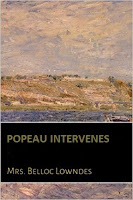An insurance investigator fears that the mysterious Baron R. is a modern day (1855) Bluebeard.Mystery Review: The Notting Hill Mystery (1862) is called "the first detective novel" and so of historical interest, even if we're unsure who wrote it. Charles Felix was a pseudonym, probably of Charles Warren Adams. It's uncertain. "Felix" also wrote Velvet Lawn (1864) and The Little House by the Railway Arch (unclear if ever published). Other candidates for the "first" are R.D. Blackmore's Clara Vaughan (1864); The Dead Letter (1866) by Seeley Regester (aka Metta Victoria Fuller); Émile Gaboriau's L'Affaire Lerouge (1866) (The Widow Lerouge or The Lerouge Affair) featuring detective Monsieur Lecoq (based on real-life thief turned detective Eugène François Vidocq); and The Moonstone (1868) by Wilkie Collins. Curious that so many contenders showed up around the same time and only a couple of decades prior to A Study in Scarlet (1887). The "detective" here is an insurance investigator named Ralph Henderson (credited on the book's title page as R. Henderson, Esq.). Our author, Charles Felix, has built this record from the sum total of Mr. Henderson's extensive investigations, which is told in letters, interview statements, diary entries, lab results, etc. The Notting Hill Mystery is ahead of its time as a sort of widely-documented epistolary-esque novel. The ending is also modern in that it's open-ended and allows the possibility that the

criminal gets away with heinous crimes: "Are crimes thus committed susceptible of proof, or even if proved, are they of a kind for which the criminal can be brought to punishment?" My copy is a digital facsimile of the original from the British Library (with the utilitarian cover pictured, circa 2011), and as such includes 32 pages of advertisements of other 1865 publications by the publisher Saunders, Otley, and Co., which are fascinating in their own right. In 2012 another digital facsimile (sans the advertisements) was published by the British Library but with the original, distinctive illustrations by George Du Maurier (Daphne's grandfather), an invaluable, investigatory Introduction by Mike Ashley, and a much more winning vintage distressed cover in brown and gold, crediting the author as Charles Warren Adams.
The Notting Hill Mystery was also republished in 2015 as part of the British Library Crime Classics series by The British Library Publishing Division and Poisoned Pen Press. This all just scrapes the surface. The story is too longwinded for modern tastes, incorporating supernatural beliefs, mesmerism, psychic twin connections, and historic prejudices (a child is kidnapped by "gipsies"). The pacing is slow and deliberate, each point well nailed down and established in a sort of "belt and suspenders" approach that one might expect from an insurance agent. For those caught up in the time machine of this contemporaneous historical novel none of that will matter, and
The Notting Hill Mystery will be a beguiling journey into the archaeology of the detective story. [4★]





